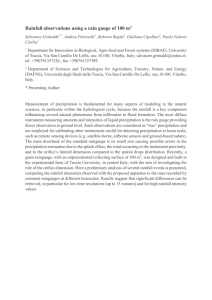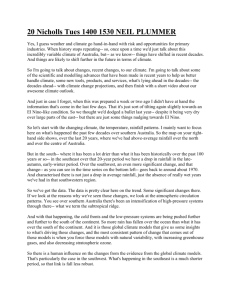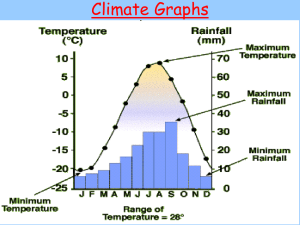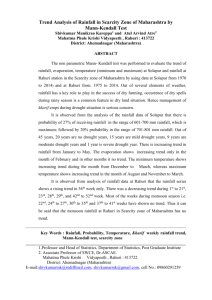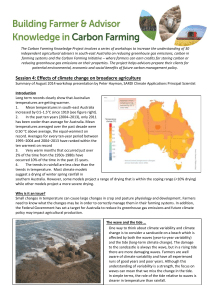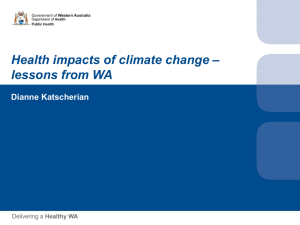Detection of trends in extreme weather phenomena
advertisement
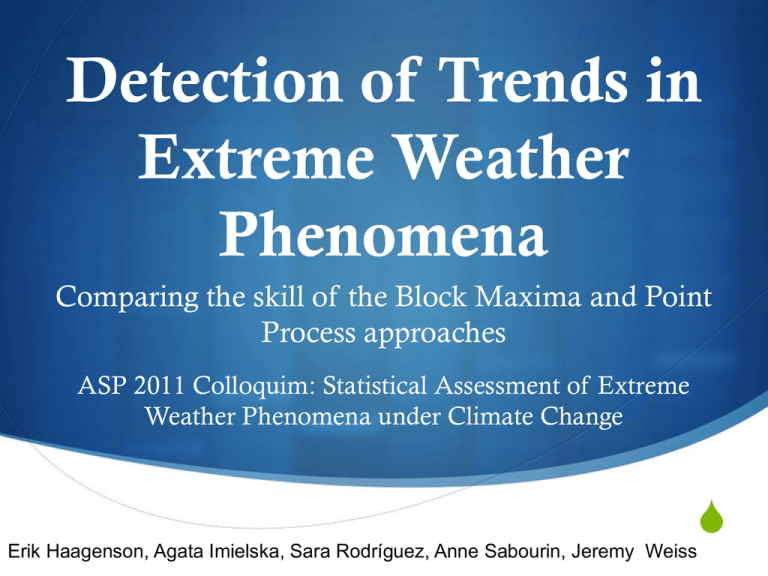
Detection of Trends in Extreme Weather Phenomena Comparing the skill of the Block Maxima and Point Process approaches ASP 2011 Colloquim: Statistical Assessment of Extreme Weather Phenomena under Climate Change S Erik Haagenson, Agata Imielska, Sara Rodríguez, Anne Sabourin, Jeremy Weiss Australian Climate Influences SWWA rainfall decline January to October rainfall in SWWA with centred 15 year moving average. Years shown in red are the five lowest on record. Trend in winter anticyclone density 1950 2010 SWWA Precipitation GENERALIZED EXTREME VALUE DISTRIBUTION ANALYSIS (GEV) 100 9619 Station Precipitation Maximum May-October S Station 9619 60 40 October) S Maximum value from each winter obtained and fit to GEV Precipitation S Winter Season (May- 80 S 1889-2004 1900 1920 1940 1960 Year 1889-2004 1980 2000 GENERALIZED EXTREME VALUE DISTRIBUTION ANALYSIS (GEV) 80 0.2 0.4 0.6 0.8 1.0 40 80 Empirical Model Return Level Plot Density Plot 100 f(z) 0.02 140 100 0.00 60 20 Return Level 60 0.04 0.0 trend in the location parameter only used to set up our experimental design 60 40 0.0 S The best fit was with a S This information was Empirical 0.4 Model 0.8 S Scale and location parameters fit with a linear trend Quantile Plot 100 Probability Plot 1e-01 1e+00 1e+02 Return Period 20 40 60 z 80 100 Experimental Setup Questions : How to simulate data ? (Given desired GEV parameters for the seasonal maxima) Given simulated data, what kind of experiment should we perform ? Data Simulation ● ● ● Season : n = 184 days. Number of wet days over a season : nδ : Poisson ditribution (mean : 84 wet days) On wet days : Rainfall X has GPD ditribution : Seasonal maximum ● Relation GEV/GPD parameters : ● Experimental Design ● Year t , simulated data has seasonal maximum (trend b in the GEV location parameter only) ● Range of tested trends : b= ( -0.1, -0.05 , -0.02 , 0 , 0.02 , 0.05 , 0.1 , 0.2 ) ● ● For each value of b : ● simulate Nsim datasets; fit on each of those: – – ● A Poisson point process model A block maxima model. How many times was the trend detected ? Results Next Steps S Expand simulations, test over a series of trends (expand curves) S Develop theoretical approximations to bound the detectability of trends to help guide detection of trends in extreme rainfall References S S S S S S S S S Bates, B.C., Hope, P., Ryan, B., Smith, I., Charles, S., 2008. Key findings from the Indian Ocean Climate Initiative and their impact on policy development in Australia, Clim. Change, 89: 339-354, doi:10.1007/s10584-007-9390-9. Bates, B.C., Chandler, R.E., Charles, S.P., Campbell, E.P., 2010. Assessment of apparent nonstationarity in time series of annual inflow, daily precipitation, and atmospheric circulation indices: A case study from southwest Western Australia. Water Resources Research, 46: W00H02, doi: 10.1029/2010WR009509. Fowler HJ, Wilby RL (2010) Detecting changes in seasonal precipitation extremes using regional climate model projections: Implications for managing fluvial flood risk. Water Resources Research 46:W03535 doi:10.1029/2008WR007636. Hennesy, K.J., Suppiah, R., Page, C.M, 1999. Australian rainfall changes, 19101995, Aust. Meteor. Mag., 48:1, 1-13. Indian Ocean Climate Initiative (IOCI) 2002, Climate Variability and Change in Southwest Western Australia, Dep. Of Environ. Water and Catchment Prot., East Perth, WA, Australia. Laverty, B.M., Kariko, A.K., Nicholls, N., 1992. A high-quality historical rainfall data set for Australia. Aust. Meteor. Mag., 40, 33-39. Li Y, Cai W, Campbell EP (2005) Statistical modeling of extreme rainfall in Southwest Western Australia. Journal of Climate 18: 852-863 Reyes H., Vaquera H. and Vilaseñor J. Estimation of trends in high urban ozone levels using the quantiles of (GEV), Environmetrics, vol. 21, pp.470-481, 2010. Zhang X, Zwiers FW, Li G (2004) Monte Carlo Experiments on the Detection of Trends in Extreme Values. Journal of Climate 17: 1945-1952 THANK YOU!!

